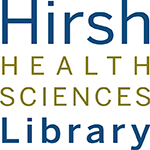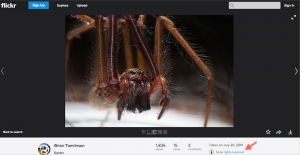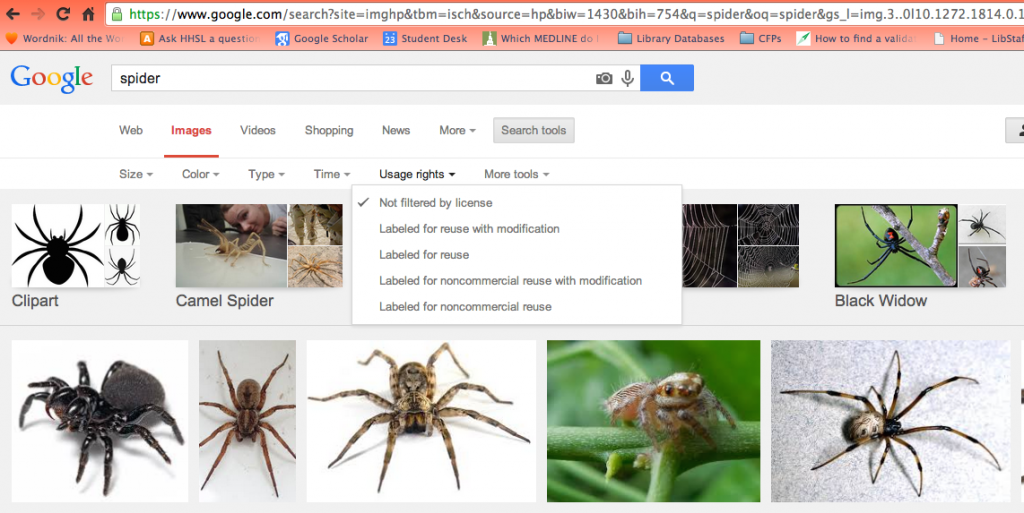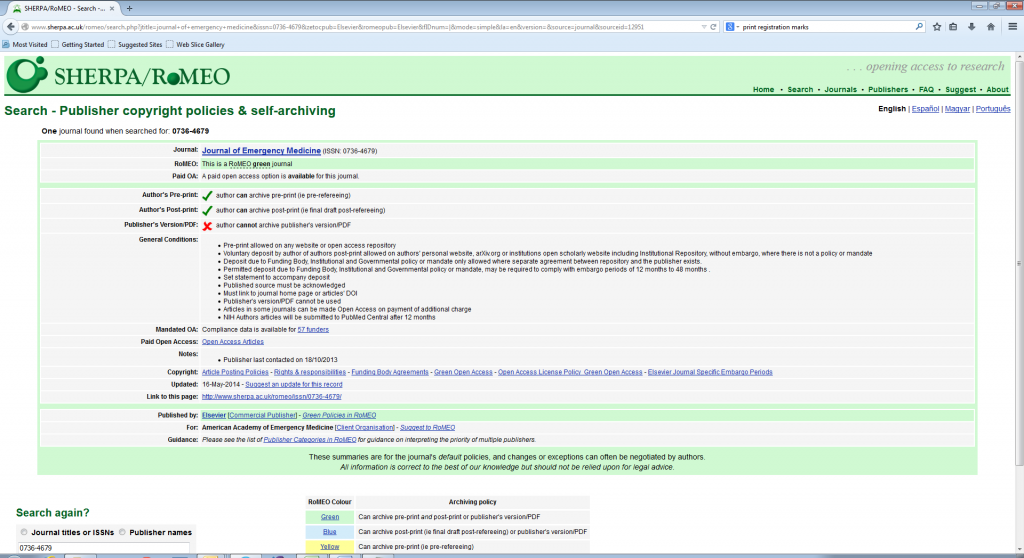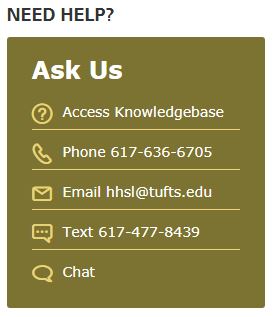Once upon a time, librarians curated what were usually called “picture collections.” These were files (actual paper files!) filled with pictures clipped from other sources that the librarians knew could be reused in articles and publications- hence the origin of the term “clip art.” When an author was working to pull together a publication, he or she would mosey over to the library or archives and work with this curated picture collection.
Then the internet happened. The wealth of images available online has created a minefield of intellectual property and academic ethics issues. Just because you can view content online for free (whether it be photos on Flickr or a copy of someone’s thesis) does not mean you can download, remix, reuse, sell commercially, or do anything you want with it. Content creators have rights.
Creative Commons licenses are a component of the open access toolkit that allows authors and creators to share their content while maintaining some important essential and creative rights to their works. In other words, issuing work under a CC license gives you the ability to freely share your work, under terms that you dictate. This differs from the public domain, which dictates that nobody owns a piece of content, and is a matter for another blog post, another day.
There are six Creative Commons licenses, which offer differing levels of reuse permission (the most common restrictions involve changing or adapting images, and making money from the reuse of images). CC has a handy tool to help creators determine what sort of license they would like to use.
When it comes to finding images licensed under Creative Commons, there are several great resources to visit and tricks to use to find images for your posters, presentations, and publications.
I suggest starting with Flickr. After you execute a search you can limit your results to Creative Commons only, as well as images that allow commercial reuse and modifications:
Once you’ve done that, you can view the specific rights for any image by clicking the Rights link (this also tells you what you are allowed to do with an image):
Google Images allows a similar search limit. After you search, select your parameters under the “Usage Rights” menu:
With all Creative Commons works, you are expected to attribute the creator and source (at the very least), and CC has a great guide to Best Practices for Attribution.
This is just a quick introduction to Creative Commons resources. If you have any questions, please contact us at hhsl@tufts.edu. Even better, attend our upcoming Open Workshop on October 30 at noon, “But I Found it Online!” Proper Use and Attribution of Images for Papers, Posters, and Presentations.” Click here for more details and to register!
Here’s a guest post from our E-Resources and Serials Librarian, Jane Natches:
Have you thought about posting your published work to your own website or your institution’s open access repository but are concerned you will be in violation of the copyright agreement you signed with the publisher?
Copyright agreements can be intimidating but there is a tool that can help you begin to understand what rights you do have for archiving your works. SHERPA RoMEO is a database of publisher’s copyright policies presented in clear and understandable language. It is intended for use by the academic research community and is easily searchable by journal title, ISSN, or publisher name.
The trick to using SHERPA RoMEO is to first determine what version(s) of your work you currently retain because publishers often have different archiving rules based on versioning.
The pre-print is the final version of your article submitted for peer review / refereeing.
The post print is the version you submitted after addressing comments from the peer review / refereeing process.
The publisher’s version is the final post print dropped into the publisher’s layout. It often includes page numbers, logos, and print registration marks and is usually in PDF format.
You may be surprised by what your standard copyright agreement allows. Many well-known publishers allow the post print to be posted to an author’s personal website or an open access institutional repository without any embargo. Additional requirements tend to be fairly simple and often include acknowledging the published source and providing a link to either the journal home page or the article’s DOI (digital object identifier).
Give it a try and see what you find!
In our continued celebration of International Open Access Week, I would like to direct your attention to some of my favorite scholarly resources that just so happen to also be Open Access or promote Open Access.
In case you need a refresher, in his book Open Access, Peter Suber writes: “The basic idea of OA is simple: Make research literature available online without price barriers and without most permission barriers.” In a nutshell, OA materials are free to access, and you can download, copy, distribute, transmit, harvest, use web crawlers, etc. for free as well. Just give attribution to authors and creators and you’ll all set.
So, can it be any good if it’s free? You bet! OA publishers have banded together to police the landscape, ensuring adherence standards regarding peer review, licensing, and research integrity, and more.
Stay tuned all week as we give you more information about OA publishing, self-archiving, other free learning materials online, and more! But for now, enjoy some of our favorite scholarly resources in the OA community.
Affiliated with the Association of Research Libraries, the Scholarly Publication and Academic Resources Coalition is an international alliance of academic and research libraries working to create a more open system of scholarly communication. Includes excellent information about Article-Level Metrics, a new approach to quantifying the reach and impact of published research.
Established in 2002, the Directory of Open Access Journals works to collect and provide access to scholarly OA journals across international borders and disciplines.
With a publishing arm over ten years old, the Public Library of Science publishes seven peer-reviewed, OA journals. A paper published in a PLOS journal has recently received international attention when used as supporting material in a U.S. House of Representatives hearing about the spread of the Ebola virus.
Based in the UK, BioMed Central published 269 peer-reviewed Open Access journals, including a wide array of specialty titles in medicine.
http://biodiversitylibrary.org/
Finally, I have to mention the Biodiversity Heritage Library, a consortium of natural history and botanical libraries working to digitize biodiversity literature and make it available for open access. BHL is not a publisher, but works with libraries and publishers to make important historical and current scientific literature available free to anyone with an internet connection. Besides serving some of the rarest and most remarkable literature you will ever see online, my interest in the OA world stems directly from the 6 years I spent working with BHL.
This is just a small selection of resources in an ever-expanding OA world; feel free to comment if there are others you would like to share!

Image by Andrea Higginbotham , CC BY 2.0
This week, October 20-26th, is International Open Access Week. Here at the Tufts Libraries, we decided to take this opportunity to highlight the scholarly publishing related workshops we are hosting during the month of October. In particular, be sure not to miss…
Field Guide to Spotting Predatory Publishers
Wednesday, October 22, 2014 – noon to 1:00pm
Location: Sackler 510
Advice from the Experts: Inside Scientific Publishing
Wednesday, October 29, 2014 – 10:30 to 1:30pm
Location: Sackler 607 (pizza lunch included, so be sure to register)
“But I Found it Online!” Proper Use and Attribution of Images for Papers, Posters, and Presentations
Thursday, October 30, 2014 – 12:00pm to 1:00pm
Location: Sackler 510
Open Peer Review in STEM with Dr. Cesar Berrios-Otero, Outreach Director, Faculty of 1000 Research
Thursday, October 30, 2014 – 2:00pm to 3:00pm
Location: Tisch Library Austin Room, Medford Campus
Curious to find out more about open access? Check out the Tufts Scholarly Communication website and watch this space! We’ll be posting something Open Access-related each day this week.
It’s International Open Access Week (10/21-27) and we’re already deep in celebration here at the library, but perhaps you’ve recently heard the term “open access” for another reason…

John Bohannon’s open access journals “sting” in Science has gotten a lot of people on campus talking about the subject. Did it scare you away from open access publishing? Certainly, Bohannon does demonstrate that there are some unscrupulous or sloppy open access publishers who did not conduct peer review. What he didn’t show was that junk science can be published in traditional, subscription journals too. In fact, Science itself has a pretty high number of retractions in its history according to a 2012 article in the Proceedings of the National Academy of Sciences (here’s the Science post about the PNAS article).
If something seems shady about a journal (open access or subscription) you are considering, ask your librarians (or the Tufts Scholarly Communication Team) to do some digging on the publisher.
Stay tuned for more posts this week on the Tufts Scholarly Communication Team, Tufts Open Course Ware, open data, and the White House open publication directive as we celebrate Open Access Week.
Recent Posts
Categories
- 4th Floor Tabling (3)
- affiliation (4)
- Announcements (353)
- Book/Resource Reviews (117)
- Hours (131)
- Interviews (4)
- New Titles & Resources (114)
- News & Events (266)
- Open Workshops (48)
- Outside News & Events (66)
- resources (18)
- throwback thursday (5)
- Tips & Tricks (135)
- Uncategorized (148)
Tags
4th floor affiliation books Boston circulation crafts electronic resource electronic resources events exams extended hours food fun fun lab funlab graduation HHSL Hirsh Health Sciences Library holiday holiday hours holidays hours leisure reading library fun lab library service desk library staff new books open access open access week open workshop Open Workshops reserves resources staff statistics summer survey tea Thanksgiving therapy dogs Tufts Hirsh Health Sciences Library website welcome! writing consultants writing helpFollow us @TuftsHHSL!
Twitter feed is not available at the moment.
